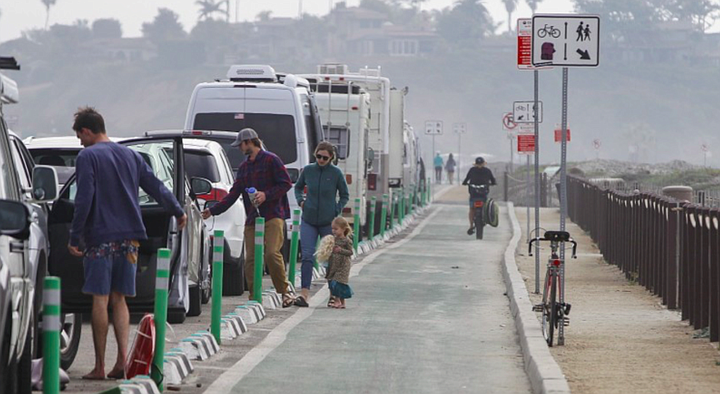 Facebook
Facebook
 X
X
 Instagram
Instagram
 TikTok
TikTok
 Youtube
Youtube

City planners and some cycling advocates insist that protected bike lanes are the best and safest way to encourage many San Diegans to ditch their cars and join the cycling transportation revolution.
Bordered by raised asphalt barriers and bright plastic pylons, these lanes create a sort of safety bubble that protects cyclists from vehicles moving alongside them, in the same direction. In theory, cyclists of all ages and abilities can enjoy the San Diego sunshine and scenery, while cars and trucks whizz by in the adjacent vehicle lane. Motorists will see the fun-loving bikers not slowed by traffic jams and join them in droves. Soon, we’ll all be pedaling together in cycling bliss.

But those rosy assurances crumble, when we confront the real dangers of protected bike lanes, and the emotional and economic cost of the accidents, injuries, and deaths that plague them.
According to statistics gathered by North County cycling advocates, there were 24 accidents — all at slow speeds — in just eight months on a one-mile flat protected bike lane stretch installed last year on the Cardiff 101 beach route. Fifteen of those crashes were caused by cyclists who collided with the raised asphalt barriers designed to keep vehicles away from the bike traffic. A ten-year-old rider flopped into the traffic lane after colliding with an asphalt barrier — but not run over by a vehicle. Many of these crashes resulted in ambulance rides to a hospital including: 1-knocked unconscious, 1-neck injury, 2-multiple bone fractures, 1-broken pelvis, 2-pedestrian crashes, and 1-hit surfboard.
The protected bike lanes on popular beachfront roads also attract pedestrians, joggers, families with strollers, beach goers carrying umbrellas, coolers, and chairs, and scores of other non-cyclists. Those pedestrians don’t always pay attention to the cyclists, which creates a serious hazard for everyone. Raised barriers are a pedestrian trip hazard. When a protected lane is on a steep grade, the added bike speed makes the situation more hazardous.

The raised asphalt barriers, plastic pylons and fences give cyclists a false sense of security. Bike riders assume cars and trucks can’t jump the barriers, but vehicles easily can. The barriers pen in the cyclists, reducing escape routes they need to avoid vehicles that drift into their bike lane, or vehicles that cut them off with a quick right turn, or their need to maneuver around obstacles and debris.
Protected bike lanes are a magnet for trash, sand and other debris. The raised barriers block the normal sweeping action created by vehicle traffic. Plus, the narrow lanes can’t accommodate street cleaning and repaving equipment. Accumulated debris and sand thus causes more falls and collisions.
A cyclist on Leucadia Boulevard suffered a much worse fate. A truck driver made a right turn in front of the rider, who was killed when he collided with the truck. The plastic pylons designed to protect the cyclist had the opposite effect; they prevented the truck driver from slowly moving towards the curb as he prepared to make that right turn onto Moonstone Court.
Those collisions are an unfortunate but predictable result of a noble but misguided plan, and flawed designs.
Experienced bike riders immediately see those dangers and most will not ride in a protected lane preferring the safety of “sharrow”-marked traffic lanes shared by both motorists and cyclists. Traditional buffered bike lanes with wide painted vehicle exclusion zones are a safer design alternative.
Plus, the supposed “extra protection” offered by the protected lanes could soon be unnecessary, as more vehicles are equipped with standard safety software for human and bicycle crash avoidance.
P.S. San Diego will be adding protected cycle tracks to Gilman Drive on a steep grade south of UCSD with five driveways.


City planners and some cycling advocates insist that protected bike lanes are the best and safest way to encourage many San Diegans to ditch their cars and join the cycling transportation revolution.
Bordered by raised asphalt barriers and bright plastic pylons, these lanes create a sort of safety bubble that protects cyclists from vehicles moving alongside them, in the same direction. In theory, cyclists of all ages and abilities can enjoy the San Diego sunshine and scenery, while cars and trucks whizz by in the adjacent vehicle lane. Motorists will see the fun-loving bikers not slowed by traffic jams and join them in droves. Soon, we’ll all be pedaling together in cycling bliss.

But those rosy assurances crumble, when we confront the real dangers of protected bike lanes, and the emotional and economic cost of the accidents, injuries, and deaths that plague them.
According to statistics gathered by North County cycling advocates, there were 24 accidents — all at slow speeds — in just eight months on a one-mile flat protected bike lane stretch installed last year on the Cardiff 101 beach route. Fifteen of those crashes were caused by cyclists who collided with the raised asphalt barriers designed to keep vehicles away from the bike traffic. A ten-year-old rider flopped into the traffic lane after colliding with an asphalt barrier — but not run over by a vehicle. Many of these crashes resulted in ambulance rides to a hospital including: 1-knocked unconscious, 1-neck injury, 2-multiple bone fractures, 1-broken pelvis, 2-pedestrian crashes, and 1-hit surfboard.
The protected bike lanes on popular beachfront roads also attract pedestrians, joggers, families with strollers, beach goers carrying umbrellas, coolers, and chairs, and scores of other non-cyclists. Those pedestrians don’t always pay attention to the cyclists, which creates a serious hazard for everyone. Raised barriers are a pedestrian trip hazard. When a protected lane is on a steep grade, the added bike speed makes the situation more hazardous.

The raised asphalt barriers, plastic pylons and fences give cyclists a false sense of security. Bike riders assume cars and trucks can’t jump the barriers, but vehicles easily can. The barriers pen in the cyclists, reducing escape routes they need to avoid vehicles that drift into their bike lane, or vehicles that cut them off with a quick right turn, or their need to maneuver around obstacles and debris.
Protected bike lanes are a magnet for trash, sand and other debris. The raised barriers block the normal sweeping action created by vehicle traffic. Plus, the narrow lanes can’t accommodate street cleaning and repaving equipment. Accumulated debris and sand thus causes more falls and collisions.
A cyclist on Leucadia Boulevard suffered a much worse fate. A truck driver made a right turn in front of the rider, who was killed when he collided with the truck. The plastic pylons designed to protect the cyclist had the opposite effect; they prevented the truck driver from slowly moving towards the curb as he prepared to make that right turn onto Moonstone Court.
Those collisions are an unfortunate but predictable result of a noble but misguided plan, and flawed designs.
Experienced bike riders immediately see those dangers and most will not ride in a protected lane preferring the safety of “sharrow”-marked traffic lanes shared by both motorists and cyclists. Traditional buffered bike lanes with wide painted vehicle exclusion zones are a safer design alternative.
Plus, the supposed “extra protection” offered by the protected lanes could soon be unnecessary, as more vehicles are equipped with standard safety software for human and bicycle crash avoidance.
P.S. San Diego will be adding protected cycle tracks to Gilman Drive on a steep grade south of UCSD with five driveways.
Comments